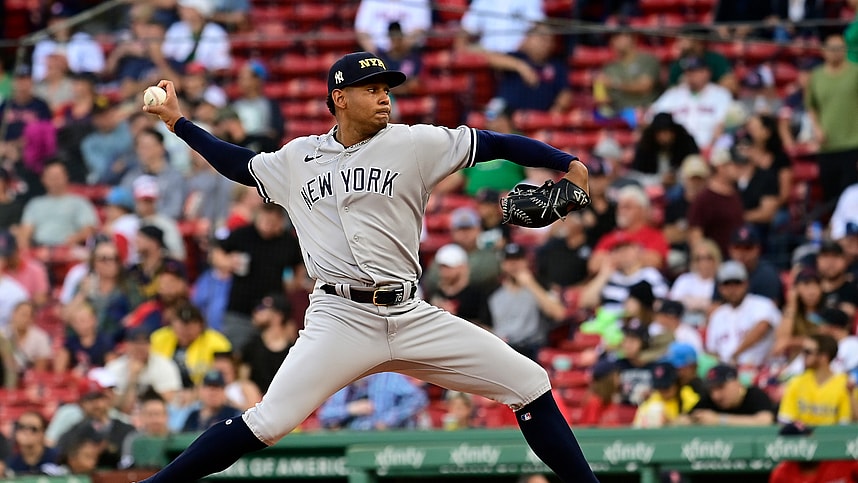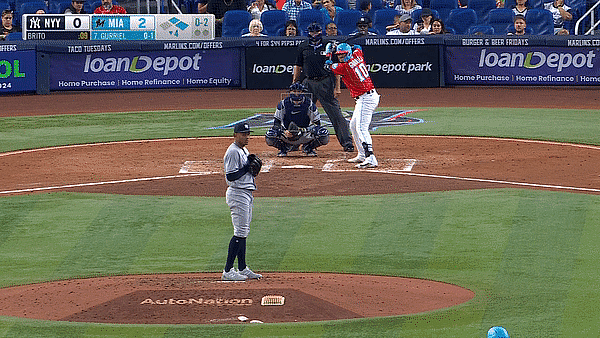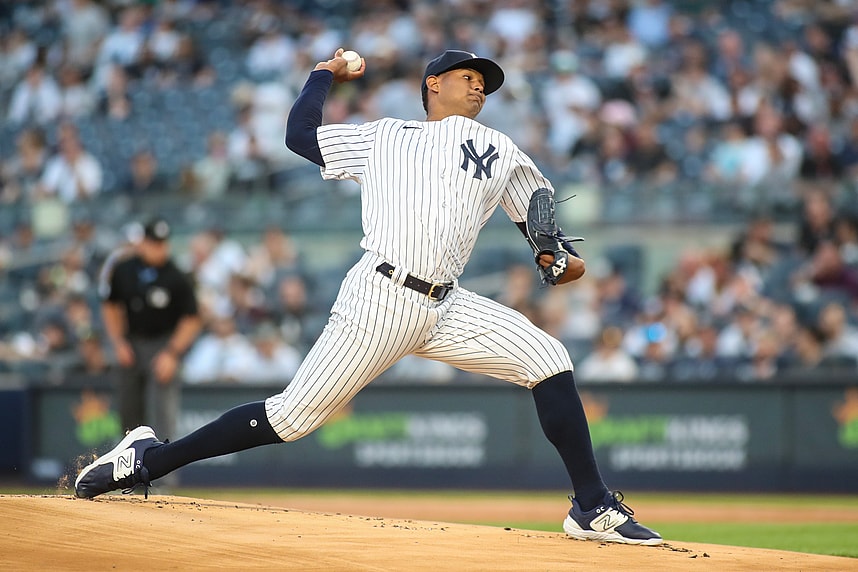
When the Yankees entered Spring Training, they anticipated that Domingo German and Clarke Schmidt would duke it out for the final rotation spot, but March brought about a familiar theme for 2023. With Frankie Montas already sidelined for most of the 2023 season, they would see both Carlos Rodon and Luis Severino hit the IL, opening up a spot in their rotation for rookie Jhony Brito, who looked great in the Spring. After a dominant start to open his 2023 season, Brito would fall on some hard times and even get demoted in-season before returning in a multi-inning relief role.
He’d make big-time adjustments to his pitch mix that would prove crucial to his success down the stretch, and while the final numbers on the season weren’t great, there was plenty to take away from a pretty exciting season for the 25-year-old right-hander. As we continue to put together the pieces of what was a perplexing season for the Yankees, we look to evaluate the names of tomorrow and see who can graduate into bigger roles come 2024.
Finally, Discovering a Reliable Breaking Ball
In Jhony Brito’s first start, the San Francisco Giants seemed to misread his flaws, stacking their lineup with six left-handed hitters, which played right into the hands of his excellent changeup. What the Giants weren’t aware of at the time was that Brito’s changeup was a plus-pitch, proving itself against the San Francisco lineup with five scoreless frames. He generated six strikeouts and used his changeup 36.8% of the time, but this was a mistake that the Minnesota Twins would not only recognize but take full advantage of in his third start of the season.
This would prove to be the point in Brito’s season where we’d see massive regression, as the Twins stacked six right-handed hitters in their lineup, forcing the inexperienced starter to rely on pitches that don’t traditionally work against same-handed hitters. It was as if Brito couldn’t put opposing batters away in that start, allowing seven runs on six hits, ballooning his ERA from 0.90 to 6.75 in just one evening. Brito would post a 4.63 ERA and 7.1% K-BB% in his following 11 appearances, and it looked as if this season would be a complete wash for him.
Behind the scenes, the Yankees began tinkering with a way for Brito to more effectively handle right-handed pitching, as he lacked a true breaking ball offering in those situations. The solution? Giving him a sweeping breaking ball to generate chases out of the zone, but it was something that he would have to learn at the Major League level due to the amount of injuries the Yankees would repeatedly suffer. His outing against the Miami Marlins on August 12th would prove to be the turning point in his season, and that sweeper would prove to be the key to the change.

From that outing against Miami onwards, Brito would post a 3.00 ERA, striking out 24% of batters faced while only walking 3.9% of them in the process. His curveball to righties began generating 14.1″ of horizontal break at 82.8 MPH, with a 45.9% Chase%, and while the command of that pitch is something he’ll have to develop more over the offseason, the fact that it was so successful this early on improved his entire arsenal as a whole. Brito began limiting hard contact as well, with a .319 xwOBACON and 0.55 HR/9 down the stretch versus a .389 xwOBACON and 1.88 HR/9 prior.
Suddenly, Brito went from a two-pitch pitcher with issues generating swings-and-misses to a pitcher with multiple offerings for both sides of the plate, allowing him to perform well to righties and lefties, a development that wasn’t expected to occur in-season but rather over the offseason or in his second year of work. He isn’t the first Yankee pitcher to take that next step after developing a sweeper, as Michael King had a similar issue in 2020 and 2021 before transitioning to the bullpen and finding that devastating breaking ball.
King learned his sweeper from Corey Kluber, who is infamous for his “Kluberball”, a breaking ball that blends the shape of a curveball and sweeper into one. Brito, King, and Kluber all had their sweeping breaking balls designated as curveballs, with King finally getting the slider/sweeper designation for it in 2022, and you’d imagine that pitch classifications will catch up to Brito’s curveball in 2024.

It helps that the 25-year-old right-hander already possesses an excellent sinker and changeup, with great velocity that allows him to overpower some hitters even with relatively inconsistent pitch shapes. Brito’s sinker finished with a 107 Stuff+ on the season, and while his overall Stuff+ of 93 isn’t great, there are two variables that cause his pitch metrics to look underwhelming.
First, changeups don’t perform well in the Stuff+ model, and that’s due to issues pertaining to data limitations with the lack of biomechanical data to understand arm speed differentials and factor them into the equation. As we collect more data and the public gets access to information that teams have held for years, we’ll get to better understand what makes for an excellent changeup, but the results (.285 wOBA, 28.2% Whiff%) are definitely encouraging for a pitch that most young arms don’t have, especially in the modern era of high velocity and big breaking pitches.
Secondly, his curveball’s Stuff+ tanks from the earlier iterations of the pitch, and with his sweeper designated as a curveball, it just comes off as a pitch that puts up significantly worse vertical movement than the typical curveball. On average, curveballs in 2023 had -9.4″ of Induced Vertical Break, whereas Brito’s only had -2.2″ IVB, and his sweeper sat closer to 1″ IVB, which is a massive difference in total drop. As pitch classifications catch up to Brito’s sweeper, so will Stuff+ models, and I’d be shocked if his sweeper doesn’t grade out as a plus pitch in most models.
With that being said, let’s give our final grades on Jhony Brito’s rookie campaign and how he can impact the Yankees in 2024.
What’s Jhony Brito’s Role on the Yankees in 2024?
I’m not ready to close the book on Jhony Brito, the starter, similar to Michael King, I believe the pitch mix is definitely good enough to be a full-time starter in this league, but it’s best if they keep him in a reliever role for now. It’s hard to argue that this hasn’t been the best role, not just for Brito but for the Yankees as well, as he’s able to save the bullpen if their starter gets chased early in the game, and he’s shown an ability to pitch against some really good lineup in close games as well.
It’ll be interesting to see if Brito tinkers with a breaking ball or cutter to left-handed hitters, as he toys around with a curveball that could be interesting, but I’m not sure it is the best option in these scenarios. Perhaps if he leans into the poor spin efficiency on the curveball more, thinking more “bullet-spin,” he could devise a breaking ball similar to the one Domingo German uses, but that’s a unique pitch and is quite the longshot. He also possesses a slider that specializes in the aforementioned bullet spin, playing a lot like a cutter with 4.1″ IVB and just 1.7″ of arm-side run, and it’s a pitch he’s exclusively thrown to left-handed hitters.

As currently constructed, his pitch mix is enough to remain an effective multi-inning reliever, but if he wants to take that next step, finding the right breaking pitch for left-handed hitters could make him a pretty good starter in this league. With that being said, the ineffectiveness as a starter hurts Brito’s final grade, but his elite production out of the bullpen with a sub-1.50 ERA gives him a pretty nice “B+” Grade on the season. His 102 ERA- hovers around average, and for a rookie, getting 90.1 innings of average production that got better throughout the season is better than what most rookies provide.
His +0.46 WPA meant he was a net-positive for the Yankees despite the poor start, and I’m extremely excited to see how he handles the larger expectations now placed on him due to his strong end to the season. This could be Michael King 2.0, and with another notch under the belt of the Yankees’ pitching development, we’re starting to see the fruit of the farm bear as the Yankees enter an offseason with plenty of legitimate questions regarding their viability in the short and long term.
More about: New York Yankees